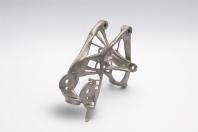Advanced Software Design Technology Leads GM to Lighter, More Efficient Vehicles

Advanced Software Design Technology Leads GM to Lighter, More Efficient Vehicles
General Motors is committed to building efficient vehicles in a responsible manner, reducing its footprint and strengthening its communities around the world. As part of those efforts, General Motors is the first automaker in North America to use new generative design software technology from Bay Area-based software company Autodesk. The technology is key to vehicle lightweighting, or developing lighter and more efficient vehicles.
Generative design technology allows engineers to rapidly explore multiple combinations of part designs by generating hundreds of high-performance design options, along with realizing vehicle mass reduction and parts consolidation opportunities. The results directly benefit vehicle owners with the potential for more interior space, increased range and enhanced vehicle performance.
“This disruptive technology provides tremendous advancements in how we can design and develop components for our future vehicles to make them lighter and more efficient,” said General Motors Vice President Ken Kelzer, Global Vehicle Components and Subsystems. “When we pair the design technology with manufacturing advancements such as 3D printing, our approach to vehicle development is completely transformed.”
General Motors and Autodesk engineers have applied this new technology to produce a proof-of-concept part — a seat bracket — that is 40 percent lighter and 20 percent stronger than the original part. It also consolidates eight different components into one 3D-printed part.
As part of a multiyear alliance focused on innovation, General Motors and Autodesk will collaborate on projects involving generative design, 3D printing and materials science.
Lightweighting has long been a focus of General Motors’ vehicle development process. Since 2016, the company has launched 14 new vehicle models with a total mass reduction of more than 5,000 pounds, or more than 350 pounds per vehicle. Most of the weight reduction are a result of material and technology advancements.
The potential savings from these lightweighting initiatives include about 35 million gallons of fuel saved and more than 300 thousand metric tons of CO2 avoided.
To learn more, see General Motors’ Sustainability Report.

